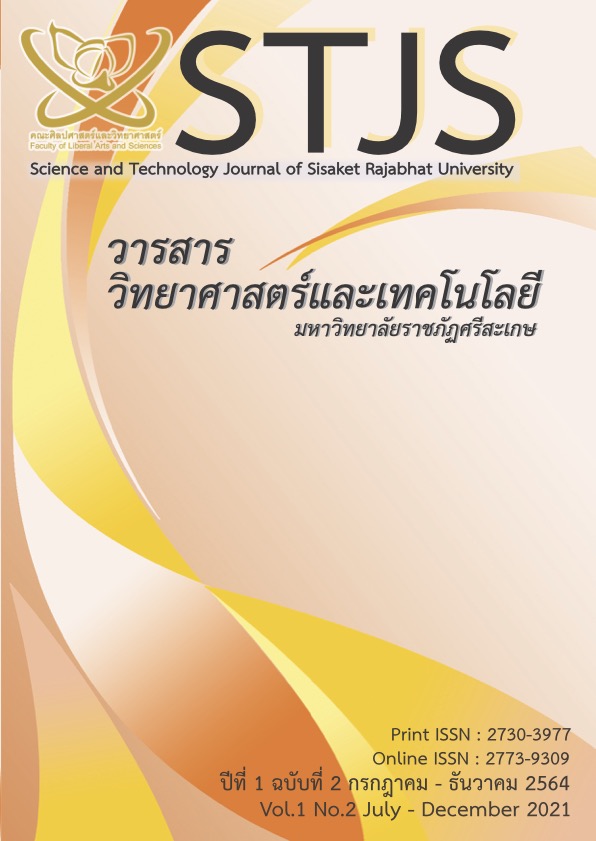Factor Related to The Quality of Life of Informal Workers
Main Article Content
Abstract
The purposes of this research were 1) to study quality of life of informal workers in Kalasin province, and 2) to study factors related to the quality-of-life informal workers in Kalasin province. The samples were 292 informal workers. This research was designed to be cross-sectional. Data were collected from survey using interviewing questionnaires. The collected data were analyzed using descriptive statistics and multiple linear regression. The results revealed that most of the informal workers were female (mostly earning less than 3,000 baht per month), who did not receive an annual physical examination, but they had history of musculoskeletal disorders. Informal workers had a quality of life at a moderate level (63.4%). Considering each domain, physical domain, psychological domain, social relationships, and environmental domain were at moderate level (80.8%, 503%, 59.2, and 56.5% respectively). The factors related with quality of life were age, monthly income, and annual physical examination (P-value were equal to 0.012, 0.006, and 0.014, respectively). Therefore, public authority should be organizing such a training to increase potential about skills for work career to increase their income and security of a full health insurance service to promote a better quality-of-life for the informal workers.
Article Details
The content and information in the articles published in the Journal of Science and Technology, Sisaket Rajabhat University reflect the opinions and responsibilities of the respective authors. The editorial board of the journal does not necessarily agree with, nor share responsibility for, these views.
Articles, information, content, images, etc., published in the Journal of Science and Technology, Sisaket Rajabhat University are copyrighted by the Faculty of Science and Technology, Sisaket Rajabhat University. If any individual or organization wishes to republish all or part of the content, or use it for any other purpose, they must obtain written permission from the Journal of Science and Technology, Sisaket Rajabhat University beforehand.
References
นนทกานต์ จันทร์อ่อน. การบริหารจัดการแรงงานนอกระบบของประเทศไทย. สำนักวิชาการสำนักงานเลขาธิการวุฒิสภา, 2556; (3)2: 1-21.
สำนักงานสถิติแห่งชาติ. แรงงานนอกระบบกับการทำงานในไทย. [อินเทอร์เน็ต]. 2560 [สืบค้นเมื่อวันที่ 15 ธันวาคม 2563] จาก: http://www.nso.go.th.
จินตนา สุวิทวัส และเนตรชนก แก้วจันทา. คุณภาพชีวิตผู้สูงอายุที่เป็นเบาหวาน. วารสารพยาบาลศาสตร์และสุขภาพ, 2555; 32(3): 29-38.
Marcela, C., Katarina, M., Eleonora, M., Serhiy, M. Informal employment and quality of life in rural areas of Ukraine. European Countryside, 2016; 2: 135-146.
สำนักงานสถิติแห่งชาติ. การสำรวจแรงงานนอกระบบ พ.ศ. 2562. [อินเทอร์เน็ต]. 2562 [สืบค้นเมื่อวันที่ 13 ธันวาคม 2563] จาก: http://www.nso.go.th.
Thant, KK., Julia, DG., Gisele, Y., Laura, G. Informal workplaces and their comparative effects on the health of street vendors and home-based garment workers in Yangon, Myanmar: a qualitative study. BMC Public Health, 2020; 20(524): 1-14.
Valentina Zigante. Informal care in Europe, Exploring Formalisation, Availability and Quality. London :European Commission. 2018.
สำนักงานสถิติจังหวัดกาฬสินธุ์. รายงานวิเคราะห์สถานการณ์การจัดทำข้อมูลเชิงพื้นที่จังหวัดกาฬสินธุ์. [อินเทอร์เน็ต]. 2561 [สืบค้นเมื่อวันที่ 10 ธันวาคม 2563] จาก: http://osthailand.nic.go.th/masterplan_area.
สุวรรณ์ ศรีอาภรณ์. โครงการส่งเสริมและพัฒนาแรงงานนอกระบบจังหวัดกาฬสินธุ์. สำนักงานประชาสัมพันธ์จังหวัดกาฬสินธุ์. อินเทอร์เน็ต]. 2558 [สืบค้นเมื่อวันที่ 13 ธันวาคม 2563] จาก: https://pr.prd.go.th/kalasin.
Mahatnirunkun, S., Tantipiwattanasakun ,W. and Pumphaisanchai, W. WHOQOL–BREF–THAI (26 items). Journal of Mental Health of Health of Thai, 1998; 5: 4-15.
Kittipichai, W., Arsa, R., Jirapongsuwan, A., … Singhakant, C. Quality of Life Among Thai Workers in Textile Dyeing Factories. Global Journal of Health Science, 2015; 7(3): 274-282.
จักรกฤณ วังทัน และนทัต อัศราภรณ์. แนวทางพัฒนาอาชีพกลุ่มแม่บ้านเกษตรกรเย็บปักถักร้อยผลิตภัณฑ์ใยกัญชงตามแนวปรัชญาของเศรษฐกิจพอเพียง. วารสารวิทยาลัยสงค์นครลำปาง, 2561; 7(1): 155–124.
Suda Hanklang. Quality of life and mental health among Thai older workers in community enterprises. Journal of Health Research, 2018; 32(3): 237-250.
Sampaothong G. Family and elderly health care. Pathum Thani: Thammasat University. 2006.
ชวพรพรรณ จันทร์ประสิทธิ์ และคณะ. (2561). สถานการณ์ด้านอาชีวอนามัยและสิ่งแวดล้อมของกลุ่มแรงงานตัดเย็บผ้า: การวิเคราะห์ในวิสาหกิจชุมชน. วารสารสภาการพยาบาล, 2561; 33(1): 61-73.
Kelly, M., Strazdins, L., Dellora. T., Sleigh, AC. Thailand’s work and health transition. International Labour Review, 2010; 149(3): 371-386.
Florey, LS., Sandro, G. and Wilson, MS. Macrosocial determinants of population health in the context of globalization. In Sandro Galea (ed.), Macrosocial determinants of population health. New York, Springer. 2007.
Rajakaruna,. R. K. G. and Kaluarachchige, I. P. Quality of Work Life and Job Satisfaction of Sewing Machine Operators in a Sri Lankan Organization. Research Symposium, 2020; 1: 73-74.
สุวิทย์ อินนามมา. แรงงานนอกระบบ: วิถีชีวิต การทํางาน การดูแลสุขภาพและสังคม กรณีศึกษากลุ่มเย็บผ้า ตําบลบ้านเม็ง อำเภอหนองเรือ ขอนแก่น. วารสารวิจัยระบบสาธารณสุข, 2553; 4(3): 379–392.
สุภัทรา ฝอฝน และคณะ. ปัจจัยที่มีอิทธิพลต่อคุณภาพชีวิตของผู้ประกอบการค้าแผงลอยในกรุงเทพมหานคร. วารสารสาธารณสุขและการพัฒนา, 2557; 12(2): 69-83.
Akazili, J., Chatio, S., Ataguba, J.E., Oduro, A. (2018). Informal workers’ access to health care services: findings from a qualitative study in the Kassena-Nankana districts of Northern Ghana. BMC International Health and Human Rights, 2018; 8(20): 1-9.


